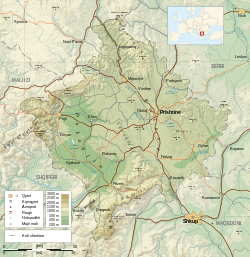| History of Kosovo |
|---|
 |
This is a timeline containing events regarding the history of Kosovo.
| History of Kosovo |
|---|
 |
This is a timeline containing events regarding the history of Kosovo.
Saviour Church is built.
This section may require cleanup to meet Wikipedia's quality standards. The specific problem is: Proper names, refs.(March 2013) |



This section may require cleanup to meet Wikipedia's quality standards. The specific problem is: Proper names, refs.(March 2013) |

This section may require cleanup to meet Wikipedia's quality standards. The specific problem is: Proper names, refs.(March 2013) |
This section may require cleanup to meet Wikipedia's quality standards. The specific problem is: Proper names, refs.(March 2013) |

The time period, 1919 – 1926 was characterized by massive deportation of Kosovar Albanians [82]
The time period, 1927 – 36 was characterized by massive migrations of Kosovars [82]
The time period, 1952 – 1965 was characterised by massive migrations of Kosovars [82]


...the Triballi who were Bastarnae neighbours, and the Dardani living in their (Triballian) land.[ full citation needed ]
{{cite web}}: CS1 maint: numeric names: authors list (link)1981 student protest kosovo.